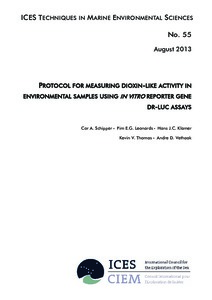| dc.contributor.author | Schipper, Cor A. | |
| dc.contributor.author | Leonards, Pim E. G. | |
| dc.contributor.author | Klamer, Hans J. C. | |
| dc.contributor.author | Thomas, Kevin V. | |
| dc.contributor.author | Vethaak, Andre D. | |
| dc.date.accessioned | 2019-01-16T00:22:12Z | |
| dc.date.available | 2019-01-16T00:22:12Z | |
| dc.date.issued | 2013 | |
| dc.identifier.citation | Schipper, C.A.; Leonards, P.E.G.; Klamer, H.J.C., Thomas, K.V. and Vethaak, A.D. (2013) Protocol for measuring dioxin-like activity in environmental samples using in vitro reporter gene DR-Luc assays. ICES Techniques in Marine Environmental Sciences, No. 55, 21pp. DOI: http://dx.doi.org/10.25607/OBP-264 | en_US |
| dc.identifier.issn | 0903–2606 | |
| dc.identifier.uri | http://hdl.handle.net/11329/707 | |
| dc.identifier.uri | http://dx.doi.org/10.25607/OBP-264 | |
| dc.description.abstract | Guidelines are given for the quantification of the dioxin-like activities of contaminants in sediment, biota and water samples using the DR-Luc reporter gene bioassay. Dioxins and dioxin-like compounds demonstrate high affinity binding to the Aryl hydrocarbon Receptor (AhR). Ah-R is a ligand-activated transcription factor and mediates most, if not all, of the toxic responses of polychlorinated dibenzo-p-dioxins (PCDDs), polychlorinated dibenzofurans (PCDFs), coplanar polychlorinated biphenyls (PCBs), and polybrominated biphenyls (PBBs). The DR-Luc bioassay, or DR-CALUX® (Dioxin Response Chemical Activated LUciferase gene eXpression), utilizes a recombinant rat hepatoma H4IIE cell line with a stably integrated AhR- responsive luciferase reporter gene. Exposure of this bioassay to extracts containing dioxin-like compounds induces the enzyme luciferase in a time, dose, and chemical specific manner. Cells are cultured in the laboratory and transferred to 96-well plates. Luciferase activity is determined by measuring the light emitted, which is directly proportional to the amount of dioxin-like compounds within the test extract. Hence the DR-Luc assay is a rapid, extremely sensitive and cost-effective tool for screening sediment, biota, and water extracts for dioxins and dioxin-like compounds. The DR- Luc assay is recommended in the OSPAR JAMP guidelines as a specific biological effect method for monitoring of PCBs, polychlorinated dibenzodioxins and furans, and also as a suitable biological effect method for general biological effect monitoring. In addition, DR-Luc analysis has proven to be a very powerful tool in emission source monitoring and remediation efforts as it allows for the identification and control of the toxic compounds concerned. Critical steps, such as the extraction of sediment or biota samples and subsequent clean-up of the extracts are discussed, followed by descriptions of the DR-Luc detection technique. Emphasis is placed on analytical quality control and quality assurance. | en_US |
| dc.language.iso | en | en_US |
| dc.publisher | International Council for the Exploration of the Sea (ICES) | en_US |
| dc.relation.ispartofseries | ICES Techniques in Marine Environmental Sciences; 55 | |
| dc.title | Protocol for measuring dioxin-like activity in environmental sample using in vitro reporter gene dr-luc assays. | en_US |
| dc.type | Report | en_US |
| dc.description.status | Published | en_US |
| dc.format.pages | 21pp. | en_US |
| dc.description.refereed | Refereed | en_US |
| dc.publisher.place | Copenhagen, Denmark | en_US |
| dc.description.currentstatus | Current | en_US |
| dc.description.sdg | 14.1 | |
| dc.description.bptype | Standard Operating Procedure | en_US |
| dc.description.bptype | Guide | en_US |
| obps.contact.contactemail | info@ices.dk | |
| obps.resourceurl.publisher | http://ices.dk/publications/library/ | en_US |
 Repository of community practices in Ocean Research, Applications and Data/Information Management
Repository of community practices in Ocean Research, Applications and Data/Information Management
